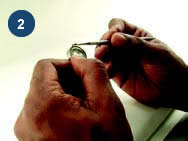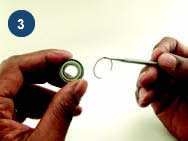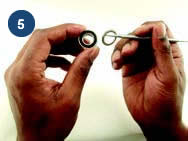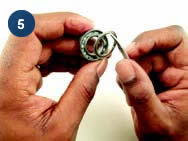How To Maintain Your Bearings
If your bearings have a metal shield on them, you do not have to remove the shield to clean them. If your bearings have a rubber seal then you should remove the seals according to the instructions below. Doing this achieves maximum performance. Using our Clean Touch bearing cleaner, or any standard degreaser, fill a small glass cup or vial sufficiently to submerge your bearings completely. Place the shielded bearings, or the sealed bearings with the seals removed, into the solution. You can also use a small ultrasonic cleaner if you have one.
Soaking time may vary depending on whether you have grease or oil in your bearings or if you are using an ultrasonic, but a few hours of soaking should be more than enough. You can now either blow your bearings dry with compressed air or allow them to air dry for up to 24 hours. For maximum performance the bearings should be thoroughly dry. At this point you can spin test the bearing on an awl or any sharp pointed tool like our Utility Tool. If the bearings do not spin to your satisfaction you may need to repeat the cleaning and drying process.
We also suggest using an additional pre-soak step that will further lubricate and protect the bearing. Our LBT Bearing Soak is specially designed to form a molecular bond with all moving metal parts. It will fill in the pores, pits and gaps typically found in chrome or stainless steel. Soaking bearings for 10-15 minutes in LBT Bearing Soak will reduce friction, decrease wear and extend life.
The final step is lubrication. A 10-20% fill is more than sufficient but be sure to not over-lube. Use a light drop of a low viscosity lubrication such as our High Speed Oil if you are seeking a pronounced free spinning bearing. For the best protection however we suggest using a heavy duty grease like our Grease Power lubrication. If you are using a shielded bearing or an orange seal bearing you can apply the oil to the bearing with the seals/shields intact. If you are using a contact sealed bearing or grease you will need to remove the seals/shields to apply the lubrication.
TIPS FOR REMOVING SHIELDS & SEALS
REMOVING SHIELDS (C-CLIP) |
||||
 |
 |
 |
 |
 |
|
Move an awl or dental tool around the inside of the outer race to locate the end of the c-clip. |
Pry up one end of the c-clip. |
Completely remove c-clip. |
Wedge your tool against the edge of the remaining shield. |
Completely remove shield. |
REMOVING SHEILDS (FIXED) |
||||
 |
 |
 |
 |
 |
|
Using an awl or dental tool gently pierce a small hole into the shield as far toward the outer diameter as possible. |
Place bearing on flat surface. |
Insert tool into puncture hole. |
Slowly pry shield from bearing. |
Completely remove shield. |
REMOVING SEALS |
||||
 |
 |
 |
||
|
Using an awl or dental tool locate the inside edge of the outer race. |
Gently wedge the tool under the edge of the seal. |
Completely remove seals. |
||
PRODUCTS MENTIONED :




